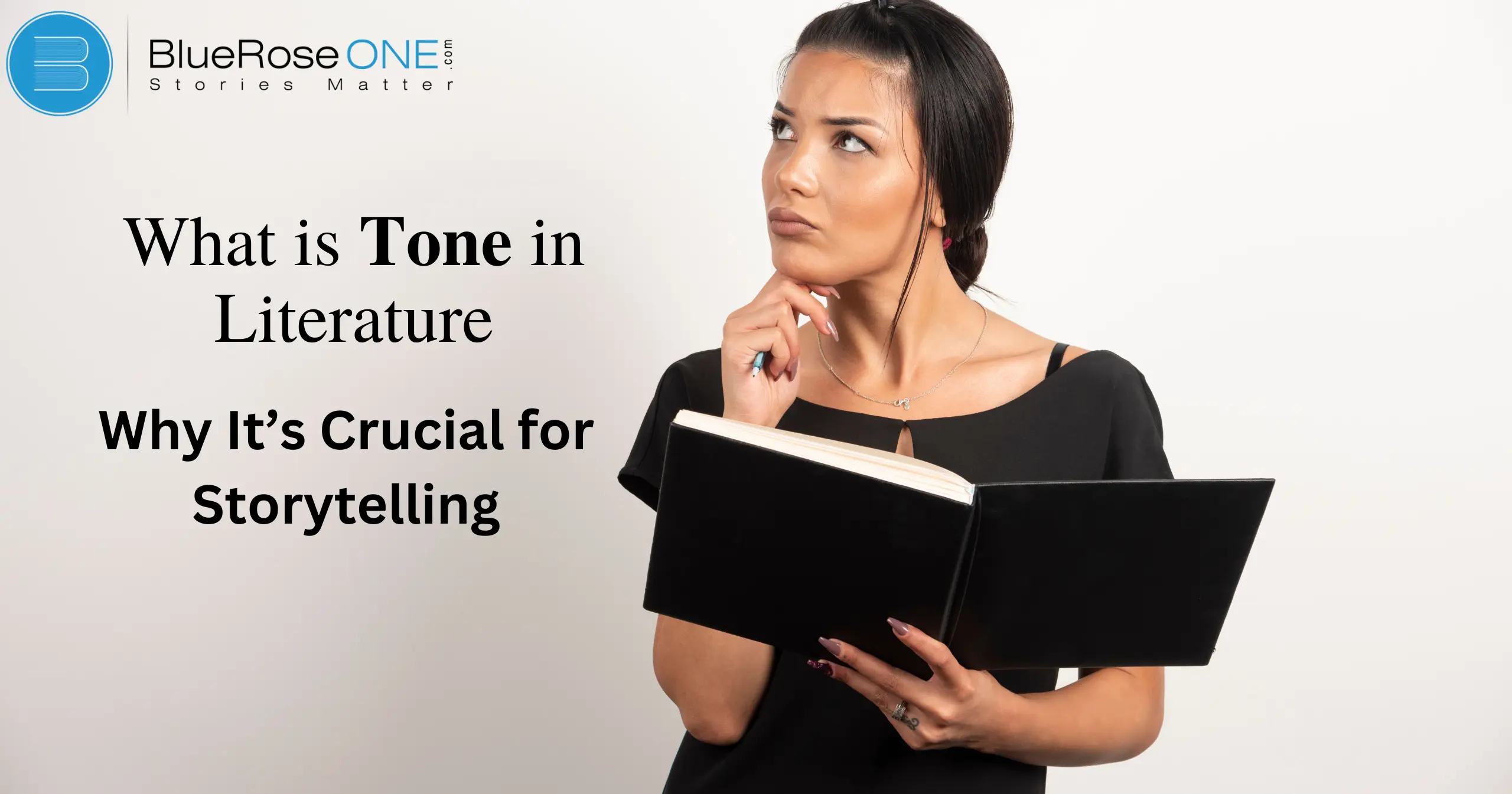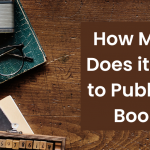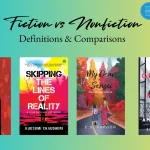Tone is like the seasoning of a story. It shapes the flavor, emotion, and experience for the reader, adding depth and texture to the narrative. But what exactly is tone in literature? Why is it such a vital component of storytelling?
Let’s dive in and uncover the fascinating world of tone and its significance in crafting compelling stories.
What is Tone in Literature?
Tone in literature relates to the author’s attitude or approach to the subject, characters, and readership. It is expressed through word choice, sentence construction, and narrative style, which influence how readers interpret and react to the story.
Consider tone to be the author’s voice in the background, quietly influencing how you perceive the plot. Tone, as opposed to mood, represents how the author feels and how they choose to express those emotions in their work.
You may also like: How to Publish a Book? | Publish Your Book | BlueRoseOne
Types of Tone in Literature
Tone comes in a wide variety of flavors, each contributing a unique sense to the story. Here are some common types:
Formal Tone
In literature, a formal tone conveys professionalism, authority, and respect. This tone in literature is frequently found in academic writing, legal documents, and classical works where the language is more refined and disciplined.
A formal tone is achieved through the use of complicated phrase patterns, sophisticated language, and an objective stance. It helps establish the importance of a subject, ensuring readers see the text with the expected gravitas.
Informal Tone
In literature, an informal tone is casual, conversational, and unhurried. It frequently employs common language, slang, and abbreviations, making it appear more personal and approachable to readers.
This tone in writing fosters a pleasant relationship between the author and the listener, making difficult concepts more understandable.
Authors utilize an informal tone to attract readers, particularly in stories about personal experiences, light-hearted themes, or character-driven storytelling.
Optimistic Tone
An optimistic tone in literature indicates a hopeful and good view, frequently inspiring optimism in the future. Writers employ this tone to portray encouragement, resilience, and faith in a positive outcome, especially in difficult conditions.
This tone can uplift the reader and help them connect emotionally with the characters or the story’s theme. In literature, tone is important because it impacts the reader’s emotional response and deepens their engagement with the story.
You may also read: What is Cozy Mystery? A Beginner’s Complete Guide
Pessimistic Tone
A pessimistic tone in literature conveys a sense of despair, pessimism, or gloom. It represents a perception that things are unlikely to improve and frequently emphasizes the negative aspects of life.
This tone can be utilized to explore topics such as despair, loss, or tragedy, resulting in a mood in which characters encounter harsh situations with little hope. Authors utilize a gloomy tone to elicit strong emotions in readers, making it a great tool for storytelling.
You may also like: Top 15 Short Novels to Read in a Weekend
Serious Tone
A serious tone in literature conveys a sense of gravity and importance, often used to discuss deep, thought-provoking themes. Authors use this tone to emphasize complex topics like moral dilemmas, social issues, or tragic events.
It’s often reflected in straightforward, formal language that avoids humor or lightheartedness. By maintaining a serious tone, writers aim to evoke a thoughtful response from readers, encouraging them to engage deeply with the story’s message and meaning.
Humorous Tone
A funny tone in literature is utilized to keep readers entertained by making them laugh or grin. This tone lightens the mood of a story and frequently includes witty language, clever conversation, or hilarious circumstances.
Even when dealing with important themes, authors utilize a comedic tone to connect with readers and provide joy to the story. This type of tone in literature is necessary for establishing a lively environment that keeps readers engaged and delighted throughout the novel.
You may also like: How to Design a Book Back Cover in 5 Simple Steps
Why is Tone Crucial for Storytelling?
Tone isn’t just a stylistic choice; it’s the backbone of effective storytelling. Here’s why it matters:
Setting the Atmosphere: In literature, tone is crucial because it sets the atmosphere and mood of a story, deeply influencing how readers perceive the narrative.
The tone in literature creates a specific feeling or emotional response, whether it’s suspenseful, joyous, or melancholic. For instance, a dark, foreboding tone can make a scene feel ominous,
while a light, humorous tone can make it feel uplifting. By establishing the right tone, writers guide readers’ emotional experiences and enhance the story’s overall impact.
Enhancing Reader Engagement: The tone of literature is important for increasing reader engagement since it establishes the mood and determines how readers interpret the story.
A well-chosen tone can make scenes feel more emotional, happy, or somber, bringing readers further into the story. For example, a dark, suspenseful tone can increase tension and keep readers on edge, whereas a light, comedic tone can make a story more approachable and pleasant.
By matching the tone to the story’s themes and characters, writers can create a more immersive and fascinating experience.
Shaping Characters and Plot: The tone of literature is critical for increasing reader engagement since it establishes the mood and determines how readers interpret the story.
A well-chosen tone can make scenes feel more emotional, happy, or somber, pulling readers deeper into the story. For example, a dark, suspenseful tone can heighten tension and keep readers on edge, but a light, comedic tone can make a story more approachable and pleasant.
Writers create a more immersive and fascinating experience by matching the tone to the theme and characters of the story.
Impact on Theme and Message: The tone of literature has a significant impact on the theme and message of a story. It provides the emotional backdrop against which the narrative unfolds, directing readers’ perceptions and reactions.
A somber tone, for example, may accentuate themes of loss and melancholy, whereas a happy tone may emphasize joy and hope.
Tone ensures that the desired concepts are clearly and effectively communicated by altering how readers understand characters, events, and the overall message. Understanding the significance of tone in writing helps writers create compelling and cohesive stories.
You may also read: Best Udemy Courses for Self-Published Authors
You may also like: 150 Useful Tone Words to Describe Tone | Explanation with Examples
How Tone Impacts the Reader’s Experience
The tone of literature has a significant impact on the theme and message of a story. It provides the emotional backdrop against which the narrative unfolds, directing readers’ perceptions and reactions.
A somber tone, for example, may accentuate themes of loss and melancholy, whereas a happy tone may emphasize joy and hope.
Tone ensures that the desired concepts are clearly and effectively communicated by altering how readers understand characters, events, and the overall message. Understanding the significance of tone in writing helps writers create compelling and cohesive stories.
You may also like: How Can I Get a Book Published?
Tone vs. Mood: Understanding the Difference
Though often used interchangeably, tone and mood are distinct elements:
Tone
In literature, tone refers to the author’s attitude or approach to the subject or audience. It is expressed through word choice, style, and perspective, and can be formal, informal, serious, or playful.
While tone in literature expresses the author’s feelings, mood refers to the emotional response that the reader experiences. For example, an author’s tone might be optimistic, while the mood for the reader could be uplifting or hopeful depending on the story’s tone.
You may also read: List of Top 10 Nikita Singh Books of All Time
Mood
While tone in literature refers to the author’s attitude toward the subject or audience, mood is the feeling or atmosphere that the reader experiences. Tone shapes how the story is presented, while mood evokes specific emotional reactions from the reader.
For example, a serious tone may create a somber mood, while a lighthearted tone could result in a cheerful mood. Understanding both elements is essential for creating a powerful and immersive narrative.
For instance, a horror novel might have a grim tone, but the mood felt by the reader might be intense fear.
You may also read: How to Write a Book Description That Grabs Readers
The Role of Tone in Character Development
Tone influences how characters speak, think, and act, all of which contribute to their identity. Tone in dialogue reveals a character’s personality and emotional state, which can change as the story progresses.
For example, a character who starts out speaking in a hopeful tone may shift to a more cynical tone as the plot unfolds and they experience hardship.
Tone in Different Literary Genres
Different genres call for different tones:
-
- Fiction vs. Nonfiction: Fiction often employs a more flexible tone, while nonfiction, especially academic writing, leans toward a formal tone.
-
- Poetry and Drama: These genres often experiment with tone to enhance their lyrical and performative nature.
-
- Mystery, Fantasy, and Romance: Each genre has typical tones. Mystery might favor a suspenseful tone, while romance could lean into a hopeful or passionate tone.
You may also read: Top 10 Rhetorical Devices Devices Every Writer Should Know
How to Identify Tone in a Story
Tone can be identified by paying attention to the author’s word choices, sentence structure, and overall narrative style. Whether the tone is ironic, bitter, or compassionate, clues are scattered throughout the text, reflecting the author’s intended voice.
Some Common Misconceptions about Tone in Literature
Some writers mistakenly believe that tone must remain consistent throughout a story or that it’s the same as style. However, tone can shift based on the scene, character development, or plot twists, while style is more about the author’s unique voice.
While tone can change depending on the scene, character development, or plot twists, style is more about the author’s distinctive voice. Some writers make the mistake of thinking that tone must stay constant throughout a story or that it is synonymous with style.
You may also read: Scion of Ikshvaku By Amish Tripathi: Book Review
How to Experiment with Tone in Your Writing
To experiment with tone in literature, try adjusting your word choice, sentence structure, and dialogue to convey different emotions or attitudes.
For example, using short, abrupt sentences can create a tense tone, while longer, flowing sentences might evoke a peaceful or reflective mood.
Play with how characters speak and react to create a distinct tone that shapes the reader’s experience. Revising scenes with different tonal approaches will help you find the right emotional balance for your storytelling.
Conclusion
Tone is a powerful tool in literature. It colors the story, influences the reader’s emotions, and helps deliver the deeper themes of the narrative. Mastering tone allows writers to craft more immersive, engaging stories that leave a lasting impact on readers.
















